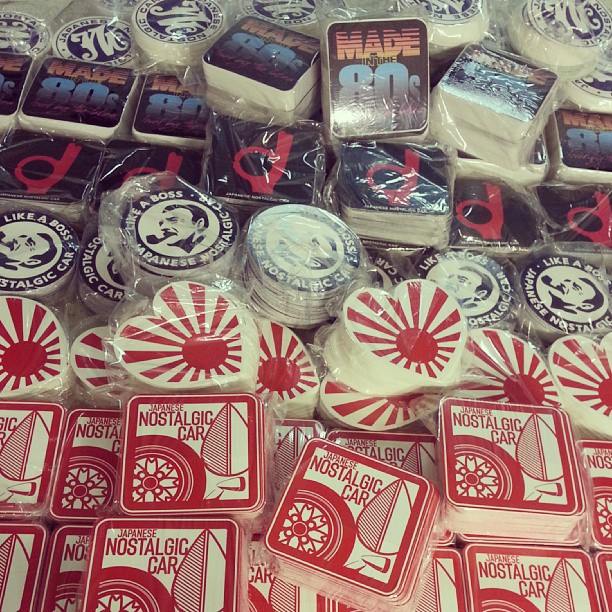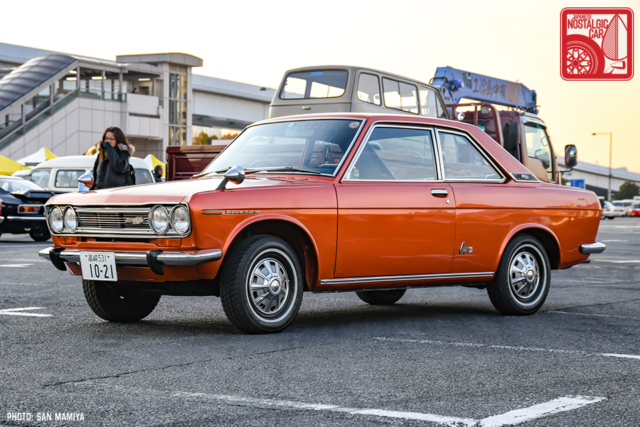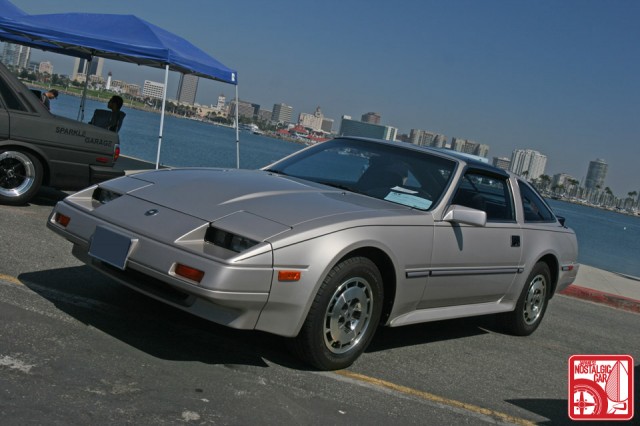Today is Respect for the Aged Day, a Japanese holiday that honors the elderly. With the introduction of a new Z, one of original models that changed western perceptions of what a Japanese car could be, it seems only fitting to consider the predecessors that have made our hobby what it is today. While the Z might be an obvious choice, one could argue that its little brother, the humble 510, put more Japanese cars in driveways. There’s no right or wrong answer, and it probably depends on what your modern favorites are.
What pivotal Japanese car made our modern favorites possible?
The most entertaining comment by next Monday will receive a prize. Scroll down to see the winner of last week’s QotW, “What’s your fondest Nissan Z-Car memory?”
We shouldn’t be surprised at the diverse stories, as the Z has touched so many lives, but it was still heartwarming to read them all. Whether it was Ellis sharing a Z experience with his dad in New Zealand or Banpei falling in love with the Z after seeing one in an obscure Dutch TV show, we had stories from all over the world.
There were stories we could all identify with, like My_Fairlady_ZFG picking up a well worn project (named “Eliza,” get it?), or Jeremy A. showing up to his first day of high school in the baddest 280ZX in town (in 2002!), or F31 Roger inheriting a pair of unregistered Zs from a shady character.
We even heard from Datsun royalty like Kathy whose father Pat Daily was a well-known racer back in the day. Geoff‘s Z got a thumbs up from Yoshihiko Matsuo himself (but thanks for the Touge shout-out as well!) and TheJWT got to tear a Z down the New Jersey Turnpike while working for the Classic Car Club Manhattan. And, we were happy that we were able to help teddy get his Z stamps from Japan.
It was ridiculously hard to pick just one winner, but this week it goes to Mike Bonanni and his tearjerker of a story involving his grandfather’s gold Z31, which launched him on a long career racing Zs.
For me it has to be walking out into my grandparent’s garage to see his new-to-him (Z31) 300ZX. Gold over tan just as you would expect in the late ’80s. It is the earliest moment in my life that I can remember admiring a specific car. I was probably 8 or 9 years old. As a kid I was always obsessed with Hot Wheels and Micro Machines but never really honed my interest into a specific car until that point. It probably had a lot to do with the day he brought it home. This was the first car in the family that everyone made a big deal over. My dad took us all over there and it was revealed to us sitting all alone in the middle of a newly cleaned out two-car garage. I will never forget walking through that door and seeing it, the adults making a big deal of it, and my grandpa bursting with pride. He unfortunately didn’t have it long as he was soon after diagnosed with Alzheimer’s and no longer able to drive.
While that car was gone and forgotten for over a decade, when I was able to purchase my first sports car in 2004 it had to be a Z, a new-to-me 2003 350Z Track Edition. That Z quickly became my first track car, evolved into my first race car, and sparked a 13-year racing “career” beginning with the early years of US time attack and ending in endurance racing (although in BMWs by then). That 350Z was sold to BC Racing North America and has been sitting somewhere in their warehouse since 2009 and you better believe I still keep close tabs on it if the owner ever wants to sell it again.
Over the years I also was able to get the first 6MT Nissan 370Z to arrive in Las Vegas back in 2009, drove that daily for 6 years, and more recently built an S30 280Z. So the Z marque is definitely deep rooted into my heart and I am excited to see the next generation!
Omedetou, your comment has earned you a set of decals from the JNC Shop!









Glad you enjoyed my Z story! It’s certainly not over and I can’t wait to see what the next chapter looks like!
That’s a great question and it seems like there could be more than one pivotal car, but if I had to choose just one, I would say the first-generation Honda Civic. It came onto the scene fairly late, the early-70s – I’m assuming that other answers will be highlighting much earlier cars – but it actually came at the exact perfect time as that was just when the gas crisis started raging in the US.
The Civic was a pretty advanced car for its time. Because of Honda’s advanced CVCC engine, the Civic didn’t need a catalytic converter and it could run on either unleaded or leaded gas, not to mention getting several times the MPG of the average American gas-guzzler at the time. Would we have had anti-pollution advances and fuel-efficient cars if the Civic never happened? Yes, of course, but it may have taken awhile for them to reach the market and have the impact that the Civic had. Honda seemed to have a crystal ball – their view of the future was pretty accurate and their timing was incredible. Make mine a 4-speed wagon, please!
For me it would be the Toyota Corolla. I was in my teens during the seventies and the Corolla did more than any other car to solidify the reputation of Japanese cars as dependable. I knew many families that had one and except for the buy American only crowd, you rarely heard a bad word said about them. Since they were so dependable they also became the car you saw most on college campuses as they were often handed down to young drivers. Truly a car that won a generation of buyers for Toyota. My car in college in the mid eighties was a 1976 Toyota Celica GT which, although it was based on the Carina chassis, most people thought it derived from the Corolla a model everyone seemed to know.
The Z and the nickle-dime are obvious answers of course. In my mind the first generation CVCC Accord was a true game-changer. While the Civic marked the first serious effort by Honda to gain a share of the U.S. mass market, the Accord was a huge step forward in that effort. Roomy, nicely constructed, and well appointed even in base trim, the Accord showed that small cars didn’t need to be cramped, inexpensive didn’t have to mean “cheap”, and family sedans and coupes could be reliable and fun to drive.
Honorable mentions to the S600/800 which eventually spawned the fabulous S2000 and to the NSX as few cars produced in the late 20th century were such game-changers.
The Toyota Land Cruiser. Toyota made a very good product study, loaded their warehouses with spares and introduced the Land Cruiser in the mountain states where the 4 wheel drive and excellent product support over came anti Japanese sentiment. Then and only then did Toyota introduce passenger vehicles made to super good standards when compared to domestic North American cars. Good design and craftmanship plus in place parts support [unlike Datsun in the introductory stages].
The Datsun 220 pickup. Very small and underpowered for the U.S., but it demonstrated that the Japanese did not need to compete with others, head-to-head, with products and features. Instead, they could “go around” the other manufacturers, by offering something different, that had merit for its own sake.
The Datsun 220 pickup, first introduced into the U.S. In the late ’50s, was a precursor of everything JNC that followed. It was the first Japanese import vehicle that was successful here, and it set the stage for more early Datsun successes (Roadster, 510, 240Z). Those old pickups still occasionally turn up on Craigslist, EBay, and other places.
For me it’s the Prince S54. Specifically the 1964 Prince Skyline GT race car used in the Japanese GP. It’s success in racing lead to the Prince Skyline 2000GT being released to market, which in turn was well received enough to pave the way for the C10 Skyline – the 2000GT-X and more importantly the GT-R.
Had the S54 not had its its chance to shine on the track, we may never have seen the likes of any of the GT-Rs that followed.
And for me the GT-R badge is one of the most important to come out of Japan. Not only are the R32s Group A exploits still talked about today and the R34 being the dream car of a generation who grew up playing Gran Turismo, but the current GT-R is still the best performance car you can buy for $100k.
I wouldn’t say it’s a single car that was pivotal for the others. I would rather say there were a few moments in Japanese post-war time which caused a rapid increase in car ownership. One of such moments was the creation of the Kei-car class which allowed private owners to own a (tiny) car for a similar price as a motorcycle.
For instance Subaru made an attempt to enter the market with a full sized sedan, but failed because there was simply not enough demand for such a product. Only when they started selling the 360 they became successful. Mazda had a similar success story with the Carol and Suzuki with the Suzulight. This increased the car ownership massively in Japan, causing environmental issues in the early 1960s.
This caused another pivotal moment when the Japanese government passed their emissions regulations in 1968 to fight the pollution of the Japanese cities. Japanese car manufacturers started to to avoid leaded petrol and focus on (back then) experimental technologies as Exhaust Gas Recirculation. In effect the Japanese cars were ready for two major events: the 1973 oil crisis (being far more fuel efficient) and the mass anti-pollution regulations of the late 1970s and early 1980s that simply chocked overseas engines.
Both were pivotal for export sales and naturally the sales of Japanese cars soared. This allowed the manufacturers to blow that extra earned cash on crazy projects like triple rotary engined cars, all-wheel-drive and all-wheel-steering supercars and launching new luxury brands that topped German reliability.
In other words: without those pivotal moments we would never have enjoyed our modern favorites (R32, Z32, Lexus LS400, Supra A80) nor would we have ever suffered from the term Camry-dent to designate a very specific prejudice. 😀
Pivotal cars… damn that is pretty tough. I feel every generation can inject something.
I always liked Japanese cars (that was pretty much what my Filipino family owned) and it seems like that was pretty dominant of the Asian communities in the PNW. Whether it was Cham, Vietnamese, Cambodian, Thai, Lao or Korean (for the most part).
I think many of us or at least our parents can trace back to their countries and find it filled with Japanese cars.
While I think most of the parents liked the cheap, gas saving Japanese cars, Quite a few did love Datsuns and Toyotas (a lot of my uncles were into Celicas and 510s).
For me and I feel most guys my age, we came up when Hondas were the car to tune. Drifting wasn’t known outside of Japan. So that would be my pivotal moment.
I felt that Honda tuning along with the fascination of the Japanese supercars (300zx, 3000GT, RX7, Supra and Skylines) made the aftermarket for Japanese cars great in America. So the Honda Civic would be that pivotal car in the 2000s.
I remember when I had my 240sx and the only thing I could find was an Injen Intake. Now the 240sx is like the civic of that era… tons of aftermarket support and people wanting to get the car to build.
Subaru 360; Post War Japan’s answer to a car for the masses. It was one of the first mass produced Kei cars with all 360 cubic centimeters. .No Showa Snap would be complete without one in the frame. Malcom Bricklin went to Japan looking to distribute Fuji Rabbits in the US.. He came back with the 360.
While it may have since been overshadowed by its younger sibling, the iconic Fairlady Z, I think a very important and pivotal car was the Datsun Fairlady 1600/2000. It had a simple, British inspired, but Japanese rendered recipe and formula; small, lightweight, 2 seater drop top with a feisty 4 banger and very tasteful styling. Nissan developed it after turning down the Yamaha designed 2000GT, that in the end went to Toyota, and the 2 cars went head to head at the races. While I would argue that the 2000GT looks worlds better than the Nissan counterpart, the Fairlady performed better on the track and was ultimately much more attainable to the average person on an international scale. Because they piled up on scores is driveways, they got people taking. “Is that an MG? Nope it’s a Datsun!” I argue that this got the word out that there were good cars and helped trailblaze a path for other Japanese fun cars such as the Z and others. Some may argue that the Civic or the Corolla for more cars in peoples driveways. But those were originally meant to be adorable commuters, an economic answer to high gas prices. But the Fairlady was a fun car, and told America and the world that you don’t need a V8, or British import prices, to have fun.
#DoItInADatsun
While it may have since been overshadowed by its younger sibling, the iconic Fairlady Z, I think a very important and pivotal car was the Datsun Fairlady 1600/2000. It had a simple, British inspired, but Japanese rendered recipe and formula; small, lightweight, 2 seater drop top with a feisty 4 banger and very tasteful styling. Nissan developed it after turning down the Yamaha designed 2000GT, that in the end went to Toyota, and the 2 cars went head to head at the races. While I would argue that the 2000GT looks worlds better than the Nissan counterpart, the Fairlady performed better on the track and was ultimately much more attainable to the average person on an international scale. Because they piled up on scores of driveways, they got people taking. “Is that an MG? Nope it’s a Datsun!” I argue that this got the word out that there were good cars and helped trailblaze a path for other Japanese fun cars such as the Z and others. Some may argue that the Civic or the Corolla for more cars in peoples driveways. But those were originally meant to be adorable commuters, an economic answer to high gas prices. But the Fairlady was a fun car, and told America and the world that you don’t need a V8, or British import prices, to have fun.
#DoItInADatsun
While it may have since been overshadowed by its younger sibling, the iconic Fairlady Z, I think a very important and pivotal car was the Datsun Fairlady 1600/2000. It had a simple, British inspired, but Japanese rendered recipe and formula; small, lightweight, 2 seater drop top with a feisty 4 banger and very tasteful styling. Nissan developed it after turning down the Yamaha designed 2000GT, that in the end went to Toyota, and the 2 cars went head to head at the races. While I would argue that the 2000GT looks worlds better than the Nissan counterpart, the Fairlady performed better on the track and was ultimately much more attainable to the average person on an international scale. Because they piled up on scores of driveways, they got people taking. “Is that an MG? Nope it’s a Datsun!” I argue that this got the word out that there were good cars and helped trailblaze a path for other Japanese fun cars such as the Z and others. Some may argue that the Civic or the Corolla for more cars in peoples driveways. But those were originally meant to be adorable commuters, an economic answer to high gas prices. But the Fairlady was a fun car, and told America and the world that you don’t need a V8, or British import prices, to have fun.
#DoItInADatsun